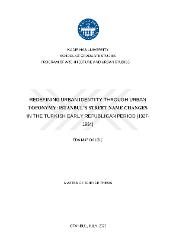| dc.contributor.advisor | Soyöz, Üyesi Ufuk | |
| dc.contributor.author | Dalgiç, Eda Nur | |
| dc.date.accessioned | 2023-10-17T20:46:22Z | |
| dc.date.available | 2023-10-17T20:46:22Z | |
| dc.date.issued | 2023 | |
| dc.identifier.uri | https://tez.yok.gov.tr/UlusalTezMerkezi/TezGoster?key=a0OMTmEd_3mfOBxT8SiBTE8mBC6j162pgWNWkAsltLS7qllg5Yg1B-VHkoLe_9gE | |
| dc.identifier.uri | https://hdl.handle.net/20.500.12469/4527 | |
| dc.description.abstract | Sokak isimlerinin, bir yeri betimlemedeki temel rolleri nedeniyle kentsel peyzajda ve günlük yaşamda tuttukları yer, onları kültürleri, yeniden yazılmış tarihi ve ideolojileri kentsel mekana yansıtmak için görsel ve dilsel açıdan önemli araçlar haline getirir. Bu durum ayrıca onları toplumsal, kültürel ve siyasal dönüşümler sırasında değişimin hedef tahtasına koyar. Osmanlı İmparatorluğu'nun ardından yeni Türk ulus devletinin kurulmasıyla birlikte farklı etnik, ırksal ve dinsel kimliklerin kent peyzajındaki izlerinin silinmesi ve kentin Türkleştirilmesi yeni Türk devletinin meşrutiyeti açısından önem taşıyordu. Bu doğrultuda Türkçe olmayan sokak adlarının değiştirilmesi kentsel mekanda meydana gelen önemli değişikliklerden biridir. Bu çalışma, İstanbul'da sokak isimlerinin değişimini sokak adlarının mekânsal bağlamını da göz önünde bulundurarak mekân, yer, kimlik, kentsel bellek ve sokak isimleri arasındaki ilişkiyi araştırmaktadır. Osman Nuri Ergin tarafından yazılan İstanbul Şehri Rehberi 1934 ve Ergin'in İstanbul Atatürk Kütüphanesi arşivinde bulunan İstanbul'un eski ve yeni sokak isimleri listeleri bu araştırmanın ana kaynaklarıdır. Bu çalışma, 1927 yılında nüfus sayım hazırlıkları sırasında kentsel mekânı düzenlemek için başlayan ve 1934 yılında İstanbul Şehri Rehberi'nin yayınlanmasına kadar devam eden isim değişikliklerini kapsamaktadır. Bu zaman aralığında yapılan değişikliklerin temel nedenleri on bir kategori altında tasnif edilmiş ve belirlenen değişim nedenleri haritalama yöntemi ile görselleştirilmiştir. Bunun yanı sıra analiz sonuçlarını içeren çeşitli veri tabloları oluşturulmuştur. Ayrıca, yeniden adlandırma sürecinin arkasındaki metodolojiyi ve halkın değişikliklere karşı tepkisini anlamak için 1927-34 arasındaki sokak isimleri değişiklikleriyle ilgili belgeler ve gazete makaleleri bulmak amacıyla çeşitli arşivler taranmıştır. | en_US |
| dc.description.abstract | The place street names hold in the urban landscape, and everyday life makes them visually and linguistically important tools to reflect cultures, rewritten history, and ideologies to the urban space. With the establishment of the new Turkish nation-state after the Ottoman Empire, erasing the traces of different ethnic, racial, and religious identities in the urban landscape and making the city Turkified was crucial regarding the new Turkish state's legitimacy. In this direction, one vital alteration in urban space was the change of non-Muslim and non-Turkish street names. This study aims to provide an interdisciplinary approach to the relationship between space, place, identity, urban memory, and street names by examining the alteration of street names in Istanbul, considering the spatial context of street names. İstanbul Şehri Rehberi 1934 (Istanbul City Guide 1934), written by Osman Nuri Ergin, and published by the Istanbul municipality and Ergin's lists of old and new street names of Istanbul, which is found in Istanbul Atatürk Library's archive, are the primary sources of this inquiry. This research covers the changes that started during the census preparations in 1927 to regulate urban space and continued until the publication of the Istanbul City Guide in 1934. The main reasons for the changes made during this period were classified under eleven categories; the determined reasons for changes were visualized with the mapping method; also, various data tables containing the analysis results were created. In addition, various archives were scrutinized to find related documents and newspaper articles about street name changes between 1927-34 to understand the methodology behind the renaming process and the public's reaction to changes. The relationship between urban space, memory, identity, and street names is investigated in this study. | en_US |
| dc.language.iso | eng | en_US |
| dc.publisher | Kadir Has Üniversitesi | en_US |
| dc.rights | info:eu-repo/semantics/openAccess | en_US |
| dc.subject | Mimarlık | en_US |
| dc.subject | Architecture ; Şehircilik ve Bölge Planlama | en_US |
| dc.title | Redefining urban identity through urban toponymy: İstanbul's street name changes in the Turkish early republican period (1927-1934) | en_US |
| dc.title.alternative | Kent kimliğinin kentsel toponomi aracılığıyla yeniden tanımlanması: Erken cumhuriyet döneminde (1927-1934) İstanbul'un sokak isimlerindeki değişiklikler | en_US |
| dc.type | masterThesis | en_US |
| dc.identifier.startpage | 1 | en_US |
| dc.identifier.endpage | 192 | en_US |
| dc.department | Enstitüler, Lisansüstü Eğitim Enstitüsü, Mimarlık Ana Bilim Dalı | en_US |
| dc.institutionauthor | Dalgiç, Eda Nur | |
| dc.relation.publicationcategory | Tez | en_US |
| dc.identifier.yoktezid | 819915 | en_US |
| dc.khas | 20231017-Tez | rn_US |
















